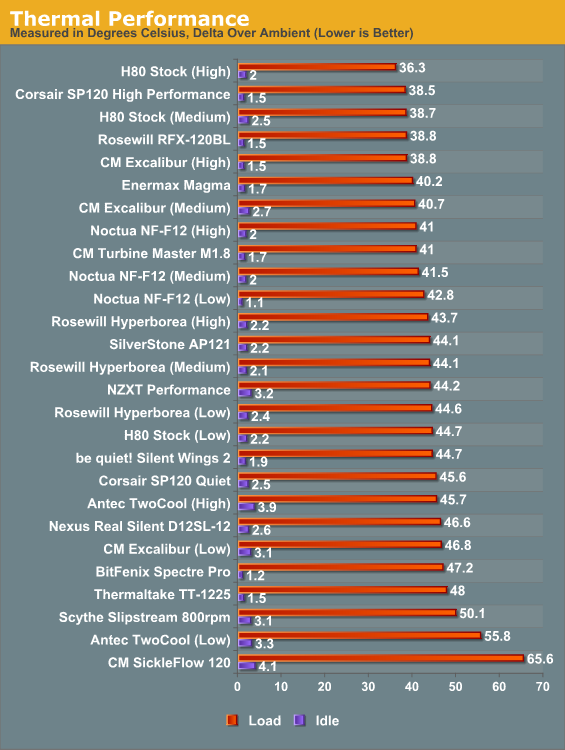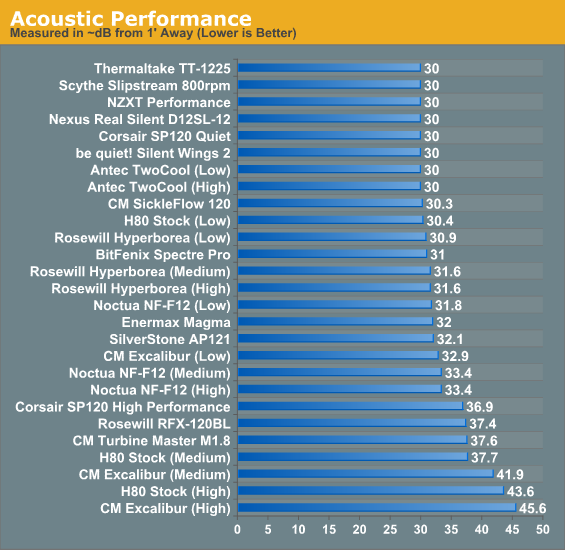120mm Radiator Fan Roundup Part 2: Fan Harder
by Dustin Sklavos on October 22, 2012 12:01 AM ESTTest Results
These are going to be...big charts. For comparison's sake I'm including a basic table first that has the stats for the previous fans I tested along with the ten new fans I tested in this roundup. That should give you a pretty solid refresher. Note that the PWM fans will be tested at the Corsair H80's low, medium, and high fan settings while the standard 3-pin voltage-driven fans are stuck at their highest setting. The exception is the Antec TwoCool 120 which has a built in speed switch that toggles between low and high speeds.
| Fan | Airflow (in CFM) | Static Pressure (in mm/H2O) | RPM | Rated dBA |
| H80 Stock | 46-92 | 1.6-7.7 | 1300-2500 | 22-39 |
| SP120 Quiet |
37.85 |
1.29 | 1450 | 23 |
| SP120 High Performance | 62.74 | 3.1 | 2350 | 35 |
| SilverStone AP121 | 35.36 | 1.71 | 1500 | 22.4 |
| BitFenix Spectre Pro | 56.22 | 1.24 | 1200 | 18.9 |
| Nexus Real Silent D12SL-12 | 36.87 | 1.2 | 1000 | 18 |
| CoolerMaster SickleFlow 120 | 69.69 | 2.94 | 2000 | 19 |
| NZXT Performance | 47.27 | 0.95 | 1300 | 25.35 |
| Enermax Magma | 69.15 | 1.4 | 1500 | 18 |
| CoolerMaster Excalibur | 26.4-85.6 | 0.75-3.53 | 600-2000 | 13-30 |
| CoolerMaster TM MACH 1.8 | 80.3 | 1.96 | 1800 | 30.5 |
| Noctua NF-F12 | 55 | 2.61 | 1500 | 22.4 |
| Scythe Slipstream | 40.17 | N/A | 800 | 10.7 |
| Thermaltake TT-1225 | 41.6 | N/A | 1400 | 21 |
| Antec TwoCool 120 | 21.3/42.6 | 0.24/0.96 | 600/1200 | 17/23.7 |
| Rosewill Hyperborea | 57.53 | 2.64 | 600-1300 | 6.9-16.05 |
| Rosewill RFX-120BL | 87.5 | N/A | 2200 | 38.15 |
| be quiet! Silent Wings 2 | 50.5 | 1.63 | 1500 | 15.7 |
As you can see, a lot of the vendors...like to flatter themselves. In fact, of the entire lineup only five are rated for noise above the noise floor of most commonly available consumer and even prosumer sound meters (that being 30dBA.) The best fan just from looking at the ratings would be the CoolerMaster SickleFlow 120 with its high static pressure, air flow, and low rated noise, but that fan turned out to be the worst fan in our last roundup by a long shot. Bottom line: don't believe everything you read on the packaging.
Ambient temperature during testing hovered between 23C and 25C. California has very strange weather. The margin for error on results is roughly 1C, and I'd strongly encourage you to mostly ignore the idle readings, which seem to show a little more variance and less reliability than the burned in load readings. I include them only for completeness' sake.

Corsair's solutions continue to be among the best performing if you're not at all concerned with noise. The H80's stock fan at its highest setting still remains essentially unstoppable and in fact offers excellent performance even at its medium setting. Interestingly, it turns out my wonderfully quiet Scythe Slipstream 800rpm fan barely moves any air; there are other fans that are nearly as quiet but produce substantially better thermal performance. Ultimately what we really need to beat is the H80 stock fan, though, and that seems to be easier said than done. Now let's see the noise levels under load.

As much as I'd like to say there's a pretty clear relationship between noise and thermal performance, there are still nuances to tease out. The CoolerMaster fans, for example, perform louder than the H80 stock fan while being less efficient.
There are a couple of data points I do want to tease out. First, the Enermax Magma is for the most part readily available in retail, reasonably priced, and may actually be the best balanced fan in the roundup. It lacks PWM control, but it offers performance near the top of the performance chart at only 32dB; that's about 5dB lower than all of the other fans above it. The Magma is popular on forums and with these results in hand it's easy to see why.
Out of the sub-31dB club, though, there's a surprise victory: the Rosewill Hyperborea PWM fan. The Hyperborea isn't really capable of producing much better performance at higher speeds, making its PWM capability mostly for show, but if you're looking for an aftermarket fan it's basically competitive with both the stock H80 fan and the NZXT Performance fan.
And what about the much ballyhooed Noctua? As it turns out, if you run the NF-F12 at a low speed it's able to produce nearly competitive performance with Enermax's option. The draw here is that the NF-F12 is much easier to get to run quieter and the character of its noise is actually less intrusive than many of the other fans; it's a fancier fan with more control, but you do pay handsomely for the privilege of owning one.
Past these notables, everything kind of blurs together.










81 Comments
View All Comments
Finally - Monday, October 22, 2012 - link
Here is the latest Fan roundup (number sixteen!) of Summer 2012: http://www.orthy.de/2012/07/354/I found the cooling performance to be irrelevant.
As long as you have 3 fans in your case (1 for the CPU, 1 at the front and 1 in the back), temperatures tend to stay in the green all the time.
Sure, I could crank them all up to max RPM, but the few extra degrees I would gain are not worth the increase in noise...
DanNeely - Monday, October 22, 2012 - link
The main reason for water cooling instead of using an air cooler is to push your CPU to near the redline. In that area a few degrees of additional cooling do matter.Finally - Monday, October 22, 2012 - link
You are preaching to the wrong crowd. I like my PC undervolted, cool and QUIET.TeXWiller - Monday, October 22, 2012 - link
<quote>some of the European brand fans seem to cost more than two times as much in the US</quote>Those Noctua fans are expensive everywhere. Of course, add the VAT to the prices in Europe. Noctua promises really high MTBF numbers and long waranties compared to most other manufacturers. I personally have been using those lower end Papst fans for some time already. A fan with 80000 hour MTBF is apparently more durable than a hard drive with 800000 hour MTBF. ;)tty4 - Monday, October 22, 2012 - link
The prices in Europe usually include taxes, the Noctua is ~18EUR online (in Germany), which is about 24USD, which already includes 20% sales tax. So the price in the US should be more like 20USD, while is seems to be 30USD, which is a rather large price difference.DanNeely - Monday, October 22, 2012 - link
Instead of trying to match up noise/performance numbers from two bar graphs could you do a noise vs temperature scatterplot?maximumGPU - Monday, October 22, 2012 - link
I second that, It would be so much more useful!Dustin Sklavos - Monday, October 22, 2012 - link
That...is a really good idea...and I'm ashamed of myself for not having thought of it. Not for this review (I'm seriously backlogged and we have a boatload of stuff coming in), but that's exactly what I've been looking for for my case reviews.DanNeely - Monday, October 22, 2012 - link
Are the numbers available in textual form anywhere? I'd like to throw them into a spreadsheet to get the plot myself; but would prefer not to have to type them in manually.DanNeely - Tuesday, October 23, 2012 - link
Ok, I typed everything into Excel; and after the usual inordinate amount of fighting (to include a detour fighting with Google's spreadsheet too) managed to get a temperature vs noise plot. I'm not really happy about its legability, but with most of the points packed into a fairly narrow area of the graph it's really not practical to try and put labels next to each point.http://orthogonaltonormal.com/midden/fans.png
If anyone wants to try and make a better chart, here's the raw data too:
http://orthogonaltonormal.com/midden/fans.xlsx